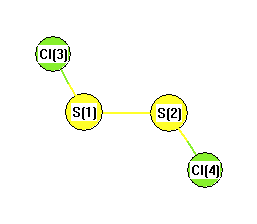.
| squib |
reference |
DOI |
| 1940Smy/Lew:1219 |
CP Smyth, GL Lewis, AJ Grossman, FB Jennings III "The Dipole Moments and Structures of Certain Compounds of Sulfur, Selenium and Phosphorus" J. Am. Chem. Soc. 1940, 62, 5, 1219-1223 |
10.1021/ja01862a067 |
| 1975Fra/Har:161 |
SG Frankiss, DJ Harrison "Vapour State Raman spectra and thermodynamic properties of sulphur dichloride and disulphur dichloride" Spectrochimica Acta 31A, 161, 1975 |
10.1016/0584-8539(75)80227-3 |
| 1979Mar/Bro:399 |
CJ Marsden, RD Brown, PD Godfrey "Microwave spectrum and Molecular Structure of Disulphur Dichloride, S2Cl2" J. Chem. Soc. Chem. Comm. 1979, 399 |
10.1039/c39790000399 |
| JANAF |
Chase, M.W., Jr.; Davies, C.A.; Downey, J.R., Jr.; Frurip, D.J.; McDonald, R.A.; Syverud, A.N., JANAF Thermochemical Tables (Third Edition), J. Phys. Chem. Ref. Data,Suppl. 1, 1985, 14, 1. |
|
| Shim |
Shimanouchi, T. , Tables of Molecular Vibrational Frequencies, Consolidated Volu |
10.6028/NBS.NSRDS.39 |
| webbook |
NIST Chemistry Webbook (http://webbook.nist.gov/chemistry) |
10.18434/T4D303 |











